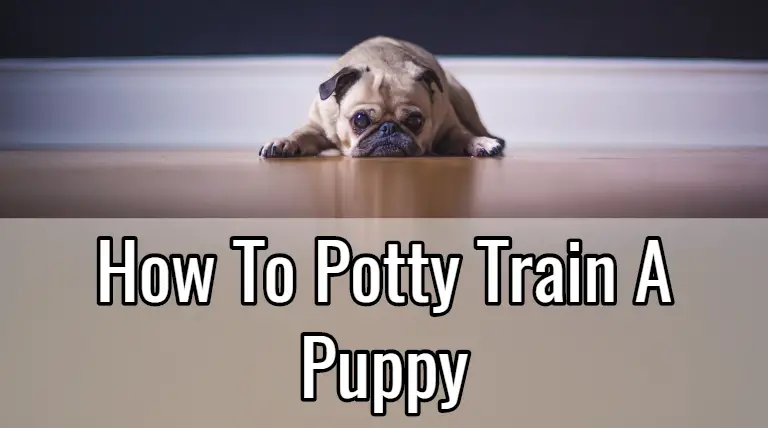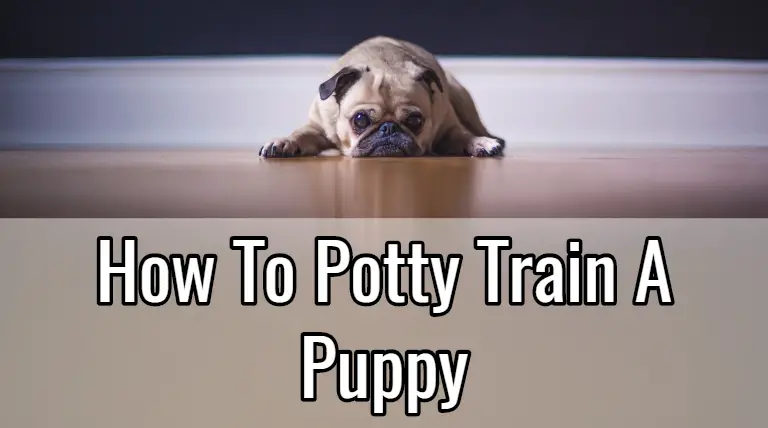Table of Contents
*This post may contain affiliate links. As an Amazon Associate we earn from qualifying purchases.
Most dog owners will be quick to tell you that how to potty train a puppy was probably the scariest part of owning a dog. But, there’s no need to be fearful! In fact, the best way to potty train a puppy won’t be nearly as hard as you might imagine. Just follow the tips below, and you’ll be well on your way to ensuring that your puppy is properly potty trained. For all your other puppy training needs, be sure to check out Puppy Training 101.
When it comes to how to housebreak a puppy, there are three key factors you need to maintain. Be consistent, be patient, and provide positive reinforcement. Keep in mind that this is going to involve a bit of work for both you and your puppy. In most cases, you’ll spend about 4-6 months housebreaking puppies. But, don’t be surprised if it can take as long as a year. Once again, the key is to make sure you’re consistent, patient, and positive. So let’s take a look at the best ways to potty train a puppy.
How to Potty Train a Puppy In 7 Steps
1. Make A Schedule
When it comes to how to housetrain a puppy, making a schedule will be very helpful. Your new puppy is a creature of habit. So, it’s going to be crucial that you keep them on a tight schedule, especially when it comes to using the bathroom.
Puppies are tiny, with tiny bladders and tiny colons. This means that anything they eat goes right through them. By maintaining a schedule that they become familiar with, your puppy will have an easier time learning when the right time to go to the bathroom is.
You’ll want to make sure you’re taking your puppy for walks, or letting them out in the yard first thing in the morning, the last thing before bed, and several other times throughout the course of the day. Except while you’re sleeping, you should be taking your puppy out every 2-3 hours, as a rule of thumb.
2. Have A Regular Feeding Schedule
Another important aspect of scheduling is when you’re feeding your puppy. Not only will feeding your puppy at regular intervals help provide structure for your dog, but it will also make it easier for you to know when your dog needs to go.
So, always be sure that your puppy is eating at the same time each day. Try and keep this schedule to the best of your ability as your puppy transitions to adulthood as well.
3. Pick Up Your Puppy’s Water Dish
You wouldn’t leave your puppy’s food out all day, and the same should hold true for their water dish as well. Puppies may have to use the bathroom as soon as a half hour after they’ve had water. So, if you’re leaving your puppy’s water dish out for them all day, you’re setting them up to fail. As a general rule, your puppy will need at least one ounce of water per day for each pound of their body weight.
So, if your puppy weighs 15 pounds, they’ll need to drink at least 15 ounces of water throughout the day. Once your puppy is potty trained, you’ll be able to leave their water dish out for them to take a drink whenever they’d like.
4. Take Your Puppy Outside Frequently
When it comes to dog potty training, taking your puppy out frequently is a win/win scenario. First, your puppy will be able to enjoy the outdoors while getting plenty of exercise. On the other hand, the more time your puppy spends with you outside, the less chance there is that you’ll be dealing with accidents inside your house or apartment.
Try and let your puppy out for exercise and to use the bathroom once every few hours. If your obligations make it difficult for you to maintain that schedule, consider asking for a little help from your family and friends.
5. Pick A Bathroom Spot
This is one of the most important aspects of how to potty train a puppy. A dog’s sense of smell is incredibly powerful, and certain smells can trigger different behaviors from your dog, including using the bathroom.
By picking a designated spot for your dog to go to the bathroom, they’ll pick up on the scent of their urine from other times they’ve used the bathroom in that spot. Once your dog picks up that smell, they’ll have a light bulb moment: “Aha! This is where I’m supposed to use the bathroom.”
6. Create A Command and Reward
By creating a command and rewarding your puppy, they’ll learn why they’re being rewarded and associate that reward with the behavior of going to the bathroom outside. Your command can be as simple as the word “outside.”
You don’t need to get too creative. Then, follow your dog outside, and when they’re finished doing their business, reward them with a treat. When it comes to rewarding your puppy, you’ll want to do so as soon as you’re sure they’re finished. If you reward them too quickly, they’ll get overly excited and forget to finish what they’re doing.
At the same time, you don’t want to wait too long to reward your puppy, either. For example, if you wait until you’re back in the house to reward your puppy, they aren’t going to associate the reward with the fact they just went to the bathroom a moment ago.
7. Praise When He/She Does Something Good
Whenever your dog engages in positive behavior, make sure that you’re rewarding them with praise. Whether they’ve learned a new command, went to the bathroom outside, or engaged in any other positive activity, make sure they know that you’re pleased with them. That way, your dog will associate positive behaviors with praise, and they’ll begin to understand that going to the bathroom outside is a positive behavior.
Puppy Potty Training Tips
In addition to the 7 steps listed above, there are some additional tips we can offer that should make potty training your puppy a breeze! For even more tips, check out Potty Train Any Dog.
Start Them Early
Potty training is going to be essential to your new puppy’s development. But, you shouldn’t wait to get started with obedience training, either. Obedience training should be started at the same time as potty training, and the two aspects will help to reinforce one another.
Diet
Make sure you’re providing with your puppy with a nutritious diet that’s designed for growing puppies. The proper food is important, and it will help ensure that your puppy is getting the protein and nutrients they need to develop.
Accidents
Accidents are going to be unavoidable when you’re training your puppy. Make sure you’re striking a balance when you reprimand your puppy when they have an accident. They need to know they’ve made a mistake, but you also shouldn’t yell at your puppy, or punish them for having an accident. An accident is an opportunity to reinforce positive behaviors, not reprimand them.
Rewards
It’s important that you reward your dog when they’re engaging in positive behaviors. You can reward them with praise as well as treats. There are plenty of different training treats available that will allow you to reward your dog with food. These treats are tiny and tasty and can be given to your pup several times per day without ruining their diet.
Supplies
You can’t do it all by yourself. You’re going to need some tools of the trade to ensure that both your puppy and you have a positive housebreaking experience. Here are some popular supplies that you may find useful when you’re potty training your dog.
Training Pads
How to train a puppy to pee on a pad is another aspect of potty training you may need to master. Training pads can be extremely useful when training your puppy. They’re also a great way to protect your floors while you potty train.
Training pads are large, absorbent pads that function sort of like a diaper. The front of the pads is designed to absorb liquid while the back of the pads is made of plastic and keep your floors safe. You’ll find plenty of different options online as well as in-store, but these are some of the best puppy pads you’ll find.
Four Paws Gigantic Wee Wee Pads
Simple Solution All Day Premium Dog Pads
Stain Removers
Even with training pads in the house, you can still expect there to be the occasional accident. When they happen, you’ll want to have a powerful stain remover on hand that’s designed specifically to remove pet stains and keep your floors looking beautiful. Here are a few of our favorites.
Nature’s Miracle Stain And Odor Remover
Dog Diapers
Some dogs are harder to potty train than others. Some owners can’t be with their puppy for as much time as they need to. Hopefully, you’ve made time to be with your puppy every step of the way as they become potty trained.
But, for those times where you know you’re not going to be able to be with your dog, you may want to consider dog diapers. That way, you’ll be able to reduce the number of accidents happening inside your home when you’re away. If you’re ever in a position where you may need a diaper for your dog, these varieties are very well regarded.
Veterinarian’s Best Comfort Fit Dog Wraps
Dry & Happy Disposable Dog Diapers
How to Potty Train a Dog: Do’s and Don’ts
Do’s:
- Positive Reinforcement
- Make plans for when you’re away
- Use a crate to house train your puppy. For more tips on crate training, check out our Crate Training 101 page.
- Clap loudly when your puppy is about to make an accident
- Let your puppy explore outside and get familiar with the area
Don’ts:
- Punish your puppy for having an accident
- React angrily by yelling, or rubbing your puppy’s nose in their accident
FAQS
How to get your puppy to pee outside?
Take them out often! The more you take your puppy outside, the more they’ll go to the bathroom outside. When they do, make sure you’re providing positive reinforcement.
How long does potty training your puppy take?
For most puppies, they’ll be completely housetrained within 4-6 months. For slower learners, it can take up to a year.
How do you house train a puppy fast?
Puppy house training isn’t an overnight process. The first rule of potty training is to be patient. There’s no such thing as a “quick fix” in this instance. But, by following these best practices, you should have an easier time training your puppy quickly.
How long can a puppy hold it during the day?
Use their age as a rule of thumb. For each month old your puppy is, that’s an hour they can reasonably be expected to hold it in. If your puppy is three months old, they should be able to hold it in for 3 hours. But, do your best to make sure your puppy can go out to the bathroom at least once every 3-4 hours.
What is the best way to potty train puppies?
Follow the 7 steps above, of course!
The key is patience and consistency.
I live in a high rise and can’t get my puppy outside for potty training. What are my choices?
You may want to consider how to pad train a dog at that point. Another option would be to hire a trainer who can provide your puppy with a better training environment.
My puppy does great sometimes but is still having too many accidents. How can I get him to be completely potty trained?
Patience! Make sure you’re rewarding your puppy when they do well. When they have an accident, try and take them outside immediately so they can begin to associate the outdoors with going to the bathroom.


